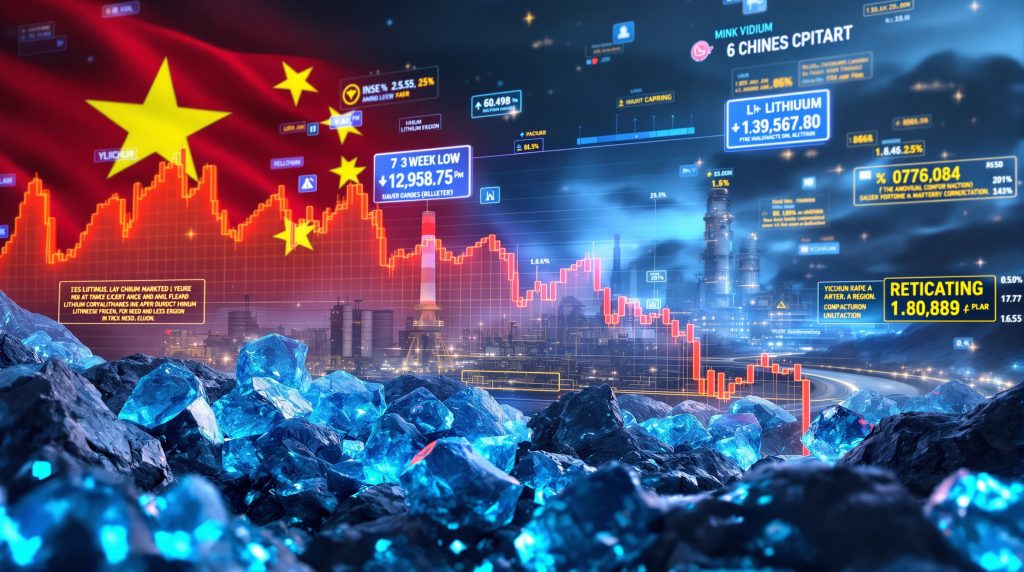What's Driving Chinese Lithium Prices to a Three-Week Low?
Chinese lithium carbonate futures hit their lowest level in nearly three weeks, touching 75,740 yuan ($10,589) per metric ton on August 28, 2025. This significant price movement marks a retreat from the one-year highs reached earlier in August, when futures had surged following production disruptions in the Yichun region of Jiangxi province.
The recent price decline reflects changing market sentiment as immediate supply disruptions appear to be resolving, though underlying regulatory challenges persist in China's lithium sector. Industry analysts note that while current prices remain volatile, the market is adjusting to new information about production continuity.
Key Market Indicators Showing Price Pressure
Market data from the Guangzhou Futures Exchange shows trading activity has been particularly intense during this period of price correction. According to commodities analysts, the current price represents a significant retreat from mid-August peaks when supply fears were at their height.
The price volatility underscores how sensitive lithium markets have become to production disruptions in China, which continues to dominate global processing capacity despite diversification efforts by international consumers. Furthermore, this ongoing lithium market downturn has raised questions about long-term industry sustainability.
How Did the CATL Mine Closure Impact the Lithium Market?
The market volatility began when Contemporary Amperex Technology (CATL), China's leading battery manufacturer, halted production at its Jianxiawo lithium mine in Yichun following the expiration of its mining license on August 9. This unexpected shutdown triggered immediate supply concerns and speculation about wider production suspensions throughout the region.
The CATL mine is strategically significant for both domestic and global lithium supply chains. As China's largest battery manufacturer, CATL's production decisions have outsized impacts on market sentiment and price discovery mechanisms.
Production Impact and Market Response
Financial analysts tracking the battery metals sector noted that the closure immediately affected market confidence. According to industry publications, lithium carbonate spot prices experienced significant upward pressure in the days following the announcement.
Battery manufacturers globally were forced to reassess supply security arrangements and potential impacts on production costs. The uncertainty surrounding the duration of the shutdown and potential for broader regulatory action amplified market responses beyond what fundamental supply changes might otherwise have justified. In addition, companies working on battery-grade lithium refinery projects in other regions are watching these developments closely.
Why Are Supply Concerns Now Easing?
The recent price decline to three-week lows reflects easing concerns about potential widespread production suspensions in Yichun. A key development was Yongxing Special Materials successfully securing renewal of its safe production license that was set to expire on September 6.
This unexpected positive development has temporarily calmed market fears about an imminent supply crisis, though longer-term regulatory questions remain unresolved.
Positive Signals for Supply Stability
According to Jinyi Su, analyst at consultancy Fubao, "The market had previously doubted the mine could successfully renew the license, so a success, especially one that came earlier than expected, really beat expectations, temporarily easing supply concerns."
Industry observers point to several factors contributing to improved market sentiment:
- No additional major mine closures have been announced following the initial CATL shutdown
- Regulators appear to be working with producers to address compliance issues
- Supply chain participants have begun adjusting procurement strategies to manage potential disruptions
- Battery manufacturers have activated contingency plans to maintain production continuity
These developments suggest that while regulatory scrutiny remains high, authorities may be taking a measured approach to enforcement that balances resource management objectives with industrial policy priorities.
What Regulatory Changes Are Affecting Chinese Lithium Production?
The volatility in Chinese lithium prices three-week low reflects a broader regulatory transformation affecting the mining sector. China's approach to lithium resource management has become increasingly sophisticated as the strategic importance of battery materials has grown with the electric vehicle revolution.
According to industry publications, Chinese authorities have implemented significant changes to mineral resource regulations that directly impact lithium producers, particularly those operating in regions like Yichun. Meanwhile, other countries like Australia are introducing Australia lithium innovations to boost their competitive position.
Key Regulatory Developments
The regulatory environment for lithium extraction in China now includes several critical components:
- More stringent approval processes for strategic mineral extraction
- Enhanced environmental compliance requirements for mining operations
- Stricter enforcement of proper mineral classification in licensing
- Greater scrutiny of existing operations' permit compliance
Mining experts note that many operations in Yichun had secured licenses for ceramic clay extraction but were actually producing lithium, creating regulatory uncertainty during renewal processes. According to Mysteel analysts, "A risk of production suspension in Jiangxi has not been eliminated as the approved mineral type is still the ceramic clay."
This classification issue represents a significant regulatory risk for producers who may face operational disruptions if authorities strictly enforce mineral type specifications during license reviews.
How Significant Is Speculative Trading in Chinese Lithium Markets?
The extreme price movements in Chinese lithium markets reflect not only fundamental supply and demand factors but also substantial speculative trading activity. The Guangzhou Futures Exchange has emerged as the primary global price discovery mechanism for lithium, with trading volumes that dwarf other international exchanges.
Market analysts tracking Chinese commodity exchanges note that lithium carbonate futures have attracted significant interest from financial traders alongside traditional industry participants, amplifying price volatility during periods of uncertainty.
Market Trading Dynamics
Financial analysts specializing in battery metals markets observe several key characteristics of current lithium trading:
- Daily price movements frequently approach exchange-imposed limits
- Significant participation from non-industry financial traders
- Trading volumes that spike dramatically during periods of market uncertainty
- Increased correlation between lithium prices and broader market sentiment
These patterns suggest that price movements may sometimes become disconnected from physical market fundamentals as speculative positioning influences short-term market direction. This financial layer adds complexity to interpreting price signals for industry participants making long-term investment decisions.
What Are the Global Implications of Chinese Lithium Price Volatility?
The volatility in Chinese lithium markets has far-reaching implications for global supply chains, international pricing mechanisms, and the broader electric vehicle industry. As the world's largest consumer and processor of lithium, China's domestic market conditions inevitably influence global trade flows and pricing.
Battery industry consultants note that pricing signals from Chinese markets directly impact investment decisions, contract negotiations, and strategic planning throughout the lithium value chain. Consequently, projects like the Thacker Pass lithium production in the US are gaining attention as potential alternatives to Chinese supply.
International Market Transmission
The interconnections between Chinese domestic markets and global lithium supply chains operate through several mechanisms:
- International miners use Chinese price benchmarks in contract negotiations
- Battery manufacturers adjust procurement strategies based on Chinese market trends
- Investment decisions for new lithium projects incorporate Chinese price forecasts
- Electric vehicle manufacturers' cost projections reflect Chinese lithium price trends
These connections mean that regulatory changes and supply disruptions in China create ripple effects throughout the global battery materials ecosystem, influencing everything from mining investment to electric vehicle pricing. For instance, recent Argentinian lithium brine insights show how South American producers are positioning themselves amid Chinese market fluctuations.
What Remains Uncertain About Future Lithium Supply?
Despite the recent price decline and easing of immediate concerns, significant uncertainties remain about Chinese lithium supply in the coming months. Market analysts warn that supply risk persists, with particular attention focused on whether seven other mines in Yichun will have to pause production after September 30.
According to Mysteel analysts, "A risk of production suspension in Jiangxi has not been eliminated as the approved mineral type is still the ceramic clay." This regulatory uncertainty creates an ongoing challenge for market participants attempting to forecast supply availability.
Key Uncertainties to Monitor
Several factors will determine future price movements in Chinese lithium markets:
- Regulatory enforcement decisions following the September 30 deadline
- Whether other producers receive license renewals similar to Yongxing
- Potential adaptation of existing operations to new regulatory requirements
- Government policy priorities regarding domestic battery supply chain security
- Market responses to continued uncertainty in production forecasts
These unresolved questions suggest that while immediate panic has subsided, the lithium market remains susceptible to renewed volatility as regulatory decisions unfold in the coming months.
How Are Battery Manufacturers Responding to Supply Uncertainty?
Battery manufacturers and electric vehicle producers are implementing various strategies to manage the supply uncertainty created by Chinese lithium market volatility. Industry participants recognize that regulatory changes in China represent a structural shift rather than a temporary disruption, requiring strategic adaptations.
Supply chain experts note that leading manufacturers have accelerated efforts to diversify sourcing and reduce dependency on regions facing regulatory uncertainty.
Adaptive Strategies
Industry leaders are pursuing multiple approaches to enhance supply security:
- Developing supply relationships with producers outside China's Yichun region
- Implementing more conservative inventory management policies to buffer against disruptions
- Accelerating research into battery chemistries that reduce lithium intensity
- Exploring vertical integration opportunities to secure priority access to raw materials
- Revising procurement contracts to include more flexible volume and pricing terms
These measures reflect a growing recognition that supply chain resilience has become a critical competitive factor in the rapidly evolving battery and electric vehicle markets.
What Does This Mean for Global Lithium Markets in 2025?
The recent volatility in Chinese lithium prices provides important insights into the evolving dynamics of global lithium supply and demand in 2025. The interplay between regulatory changes, production disruptions, and speculative trading illustrates the complex factors now shaping this critical battery material market.
Industry analysts suggest that these developments signal a maturing market where policy considerations increasingly influence fundamental supply conditions.
Market Outlook and Implications
Several key trends are emerging from the current market situation:
- Regulatory frameworks are becoming increasingly important determinants of supply availability
- Price discovery mechanisms continue to shift toward Chinese futures markets
- Supply chain participants are placing greater emphasis on geographical diversification
- Speculative trading is amplifying price volatility during periods of uncertainty
- Strategic considerations are increasingly influencing investment and procurement decisions
These trends suggest that while lithium remains essential to the energy transition, market participants must develop more sophisticated approaches to managing supply risk and price volatility in an increasingly complex environment.
Navigating Uncertainty in Critical Mineral Markets
The recent decline in Chinese lithium prices to three-week lows illustrates the complex interplay of supply disruptions, regulatory changes, and speculative trading that characterizes modern critical mineral markets. While immediate supply concerns appear to be easing, the underlying structural changes in China's approach to lithium resource management suggest continued volatility ahead.
For market participants, the key challenge will be balancing short-term responsiveness to price signals with long-term strategic planning for supply security. The events of August 2025 demonstrate that even temporary disruptions can have significant market impacts, highlighting the importance of resilient supply chains and diversified sourcing strategies.
The lithium market's evolution reflects its growing strategic importance in global energy transition plans. Companies throughout the battery supply chain are recognizing that managing regulatory risk has become as important as traditional factors like resource quality and production cost in determining competitive advantage.
As the global energy transition accelerates, lithium will remain a focal point for both commercial competition and strategic policy. The interplay between domestic regulations, global supply chains, and technological innovation will continue to shape market dynamics, creating both challenges and opportunities for producers, consumers, and investors in this critical battery metal.
Want to Stay Ahead of the Next Big ASX Mineral Discovery?
Discovery Alert's proprietary Discovery IQ model delivers immediate, real-time notifications when significant mineral discoveries are announced on the ASX, helping you identify potentially lucrative opportunities before the broader market. Explore our dedicated discoveries page to see how major mineral discoveries have generated substantial returns for early investors.




